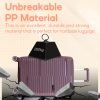“Unbreakable Luggage” typically refers to luggage that is exceptionally durable and resistant to damage, especially from rough handling during travel. Luggage manufacturers often use tough materials and construction techniques to create products that can withstand the rigors of frequent travel without breaking or sustaining significant damage. Common features of unbreakable luggage include impact-resistant shells, reinforced corners, and sturdy zippers.
One of the materials used in the construction of luggage, including some models marketed as “unbreakable,” is polypropylene (PP). Polypropylene is a type of thermoplastic polymer widely used in various industries, including luggage manufacturing. Here are some characteristics of PP material:
Lightweight: Polypropylene is generally lightweight, making it a popular choice for luggage where weight is a crucial factor, such as in airline travel.
Durable: PP is known for its durability and resistance to wear and tear. Luggage made from polypropylene is often impact-resistant and can handle rough handling during travel.
Flexibility: Polypropylene is a flexible material, allowing for some deformation without permanent damage. This flexibility contributes to the shock-absorbing properties of luggage made from PP.
Water Resistance: Polypropylene is inherently water-resistant, providing some protection to the contents of the luggage in case of exposure to moisture.
Recyclable: Polypropylene is recyclable, making it a more environmentally friendly option compared to some other materials.
When considering luggage made from PP or marketed as “unbreakable,” it’s essential to recognize that no luggage is entirely indestructible. While these materials enhance durability and resistance to damage, they may still show signs of wear over time, and extreme conditions or mishandling can potentially cause damage.
If you’re looking for “Unbreakable Luggage”, you may choose Hana, Thena, or ProX.






